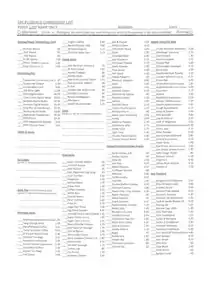Prison commissary
A prison commissary[1] or canteen[2] is a store within a correctional facility, from which inmates may purchase products such as hygiene items, snacks, writing instruments, etc. Typically inmates are not allowed to possess cash;[3] instead, they make purchases through an account with funds from money contributed by friends, family members, etc., or earned as wages. Typically, prisons set a maximum limit of funds that can be spent by each inmate on commissary.

Items used as currency
Certain items tend to be used as currency. Cigarettes were a classic medium of exchange, but in the wake of prison tobacco bans, a number of other prison commissary items have taken precedence. These include postage stamps and instant ramen noodles, which is also increasingly popular as a medium of exchange due to its versatility in prisons as food and its relative abundance.[4][5] In some prisons, Mackerel has also taken prominence as a currency, as it is priced closely with one US Dollar, and maintains stability by virtue of being rarely consumed. [6]
Popular items
Spices, including those packaged with instant ramen noodles, are a popular item due to the often bland nature of prison food.[7]
As prison budgets are cut in the US, ramen has become a popular commodity to supplement food needs.[5] Mylar foil packets of mackerel fish or "macks" are one such item.[8][9]
History
In 1930, the U.S. Department of Justice authorized and established a commissary at each federal institution.[10]
Operation
Some prison commissaries are staffed by government employees and inmates, while others have been completely privatized. Significant price markups are common in prison commissaries, although some prison systems set maximum markups; for instance, the Delaware Department of Correction has a 20% maximum markup. $100 million in purchases were made from Texas' prison system alone in 2009.[11] Prison commissary is a privilege that is often taken away for infractions.[7]
See also
References
- "FAQ: What is the Prison Commissary". Prison Fellowship. Retrieved 2020-12-18.
- "Canteen and money". www.doingtime.co.uk.
- "Gainesvillesun.com". Fadp.org. 2004-07-24. Archived from the original on 2012-02-24. Retrieved 2013-09-16.
- Gibson-Light, Michael (2018-06-01). "Ramen Politics: Informal Money and Logics of Resistance in the Contemporary American Prison". Qualitative Sociology. 41 (2): 199–220. doi:10.1007/s11133-018-9376-0. ISSN 1573-7837. Retrieved 2021-02-01.
- "Ramen noodles supplanting cigarettes as currency among prisoners". August 22, 2016.
- Scheck, Justin (3 October 2008). "Mackerel Economics in Prison Leads to Appreciation for Oily Fillets". Wall Street Journal. Retrieved 1 February 2021.
- Giudice, Teresa & Baker, K.C. (2015). Turning the Tables: From Housewife to Inmate and Back Again. Gallery Books. ISBN 9781501135101.CS1 maint: multiple names: authors list (link)
- "Incarcerations". Retrieved 30 April 2019.
- "Mackerel Economics in Prison Leads to Appreciation for Oily Fillets". Online.wsj.com. 2008-10-02. Retrieved 2013-09-16.
- "BOP: Inmate Money". Bop.gov. Retrieved 2013-09-16.
- Stiles, Matt (November 23, 2010). "Texas Prison Commissary Sales". Texas Tribune. Retrieved 2013-09-16.
Further reading
- Arthur, Steven P. Arthur (June 8, 2015). "Prison Currency's Glass Ceiling". Psychology Tomorrow.